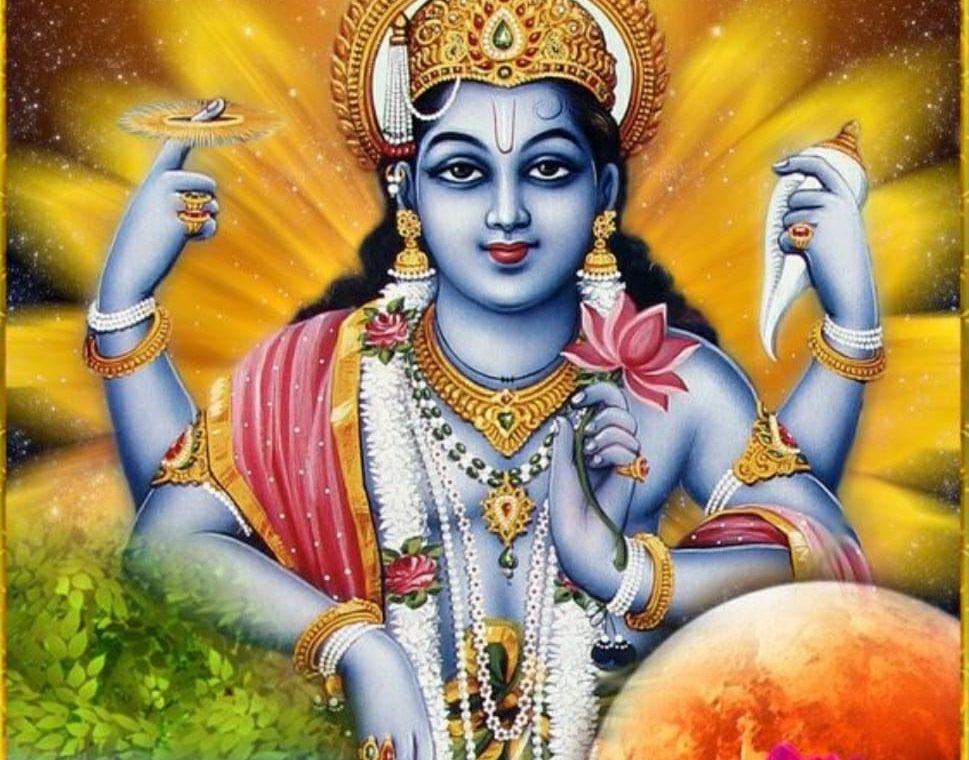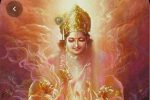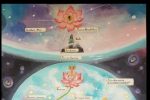NAME 55
Agrāhyaḥ अग्राह्यः
Agraahyah means ‘He who cannot be grasped’ by the organs of action as Sri Adi Sankara says ‘Karmendriyaihi na grihyate iti Agraahyah. Taitriya Upanishad says ‘Yato Vaacho nivartante apraapya manasaa sah – He cannot be described through speech, and cannot be conceived by the mind’.
Karmeṃdriyaiḥ na gr̥hyate (Grahītuṃ na śakyate) One who cannot be grasped by the organs of knowledge or conceived by the mind. To this effect there is the following śruti Yato vāco nivartane aprāpya manasā sahā (tai. 2-2) That without grasping which speech along with the mind turns back.
Na tatra cakṣurgacchati na vāggacchati no manaḥ,
Na vidmo na vijānīmo yathaitadanuśiṣyāt. (3)
Anyadeva tadviditādatho aviditādadhi,
Itiśuśruma pūrveṣāṃ ye nastadvyācacakṣire. (4)
Keno Upaniṣad- Chapter 1
The eye does not go there, nor speech, nor mind. We do not know hence we are not aware of any process of instructing about it. ‘That is surely different from the known; and again, It is above the unknown’ such was the utterance we heard of the ancient (teachers) who explained It to us.
Swami Chinmayananda gives us another interpretation. He points out that the Lord is not the ‘object’ of perception ever by any one, but He is the ‘subject’ who perceives. Thus He is ever the Subject but never the object of perception. He is imperceptible and incomprehensible. He refers us to the Kena Upanishad’s passage ‘Yat chakshushaa na pashyati yena chakshoomsi pashyanti tadeva brahma tvam viddhi’ – Understand that Brahman is That which cannot be seen by the eyes, but because of which the eyes are perceiving other things.
Agrāhya means that cannot be perceived through senses. Brahman is beyond normal human comprehension.
Taittirīya Upaniṣad (II.9) asks, “How can words express the Self. He is beyond words, thought and mind.” Brahman cannot be expressed. He can only be realised by negations and affirmations. One cannot say this is Brahman or that is Brahman, as He is omnipresent.
Kṛṣṇa confirms this in Bhagavad Gita (XI.8). He said, “You are incapable of seeing Me with your biological eyes.”
५५. ॐ अग्राह्याय नमः |
55. OM Agrāhyāya Namaḥ
Agraahyah -That which cannot (“a”) be perceived (“graahyah”) through the play of the sense organs; in short, that which is not an ‘object’ of perception, but which is the very ‘subject’-who is the Perceiver in all that is perceived.
The ‘subject’ can never become the ‘object’, and hence Truth is something that the sense organs cannot apprehend, as they do any other sense-objects. He is the one ‘subject’ ever-perceiving all objects, through all sense-organs of all living creatures, everywhere, at all times.
The Lord is the ‘subject’, not only in the sense organs, but He is the “feeler” in the mind and the “thinker” in the intellect.
And thus the sense organs cannot perceive It, nor the mind feel It, nor the intellect apprehend It; says the Upanishad, “That from which words retire unapproached along with the mind” is the Supreme. Hence He is Agraahya-Imperceptible and Incomprehensible.
Kenopanishad is very clear and emphatic: “That which the eyes cannot perceive, but because of which eyes are perceiving, understand That to be Brahman (Maha Vishnu) and not that which you here worship.”
INTERPRETATION GUIDED BY SANT VANI (WORDS OF SAINTS)
Agrahyah – The one beyond grasp.
One who cannot be grasped by the organs or knowledge or conceived by the mind. That which cannot (“A”) be perceived (“Grahyah”) through the play of the sense organs; in short, that which is not an ‘object’ of perception, but which is the very ‘subject’-who is the Perceiver in all that is perceived. The ‘subject’ can never become the ‘object’, and hence Truth is something that the sense organs cannot apprehend, as they do any other sense-objects. He is the one ‘subject’ ever-perceiving all objects, through all sense-organs of all living creatures, everywhere, at all times. The Lord is the ‘subject’, not only in the sense organs, but He is the “feeler” in the mind and the “thinker” in the intellect. And thus the sense organs cannot perceive it, nor the mind feels it, nor the intellect apprehends it; says the Upanishad, “That from which words retire un approached along with the mind” is the Supreme. Hence He is Agrahya-Imperceptible and Incomprehensible. Kenopanishad is very clear and emphatic: “That which the eyes cannot perceive, but because of which eyes are perceiving, understand That to be Brahman (Maha Vishnu) and not that which you here worship.”
The Lord is not grasped by the organs of action (Karmendriyaiḥ na gṛhyate iti agrāhyaḥ). He is never available for grahaṇa, grasping by any organ of action, be it the hands or legs. This nāma can be looked at from the standpoint of Īśvara as saguṇa-brahma, as the creator. The sarvajñatva of Īśvara is agrāhya, cannot be grasped let alone the limited capacity of the human mind which has vast potential. There are two types of avidya that we have, mūla-avidyā, an ignorance with reference to the nature of one’s ātmā and tūla-avidyā, ignorance of things other than ourselves. The Lord does not have both these types of avidyā. That Īśvara has no mūla-avidyā, self-ignorance, can be understood. But His sarvajñatva, the all-knowing nature, is agrāhya, difficult to understand.
We may know about the names and presence of many things in this universe. But we do not know all the aspects of those things. And there may be many, many more things, the presence of which, we may not even be aware of. Thus, no one can say what the word ‘all’ comprises of.
How can we, then, understand what the all- knowingness of Īśvara is? Similarly, His sarvaśaktimatva, all-powerful nature is also agrāhya. We do not now what is limitless śhakti, because the vast expanse of the jagat, with its expanding space, is not conceivable at all to the human mind.
Thus from the standpoint of our limited knowledge and limited power and skills, it is absolutely impossible to understand the sarvajñatva and the sarva-saktimatva of Īśvara. It is agrāhya, difficult to grasp by the mind, and difficult to grasp by words because the Lord is beyond the realms of what the senses can perceive.
Previously, The Lord was spoken of as aprameya, as one who cannot be objectified by any pramāṇa, any means of knowledge. Words like puṇya cannot be objectified even by anumāna, inference and can be known only through the words of the śāstra. Some people say they don’t believe in the shastra but believe in punya and papa. Whether they like it or not, this understanding comes only from the shastra – Puṇya is the result of good actions. Puṇya cannot be arrived at by inference or perception, but it’s essence can be known through śabda, the words.
That which is available as the meaning of a word is also grāhya. Śāstra describes puṇya as the adṛṣṭa, the unseen karma-phala that translates itself into pleasant situations. It is like the tree in a seed. The tree that is in an unmanifest state in a seed is not grāhya in the sense it is not available for direct perception. But, when it manifests later as a tree, it is grāhya, can be grasped. So too, puṇya though adṛṣṭa is grāhya, can be grasped when manifest as a result.
The Lord, in His essential nature as nirguṇa-brahma cannot be objectified by perception, inference or presumption. It is said, that He cannot be grasped even by the organ of speech, or words. The Taittirīyopanisad says, ‘yato vāco nivartante aprāpya manasā saha–from where the words retreat along with the mind, not having reached it’ (2.9). Why? Because words operate only with reference to jāti, guṇa, kriyā and sambandha.
Maybe the Lord can be known through unknown words such as ncsfheofwgfnkj. No. So then, known words are handled in an extraordinary way by a guru so that the Lord is revealed.
Suppose Devdutta, the corporate professional is introduced by a common friend from school, Yajnadutta to Somadutta who does not recognise him. Yajnadutta says to Somadutta, “That Devdutta is this Devdutta.” The common friend, in his recognition gives Devdutta a hug. What suddenly happened? The common friend is referring to one being only; When he says ‘that’ devdutta, he means the young school boy in shorts. By ‘This’ devdutta, he means this corporate professional who is dressed as one. What is common in ‘this’ appearance and ‘that’ appearance is a single being, which was understood by implication. This and that were the direct words, but what was meant by this and that, was a single conscious being.
The essential nature of Parameśvara is understood as only one limitless consciousness and limitlessness is not an attribute. The śabda-vācya, or the immediate meaning of words cannot reveal the limitless consciousness. Therefore, it is only the śabda-lakṣya, the implied meaning of words, which can reveal it. When the śāstra says that the limitless consciousness is not available for words, it only means, that it is not the immediate meaning, but the implied meaning of the words. It is very much available as the ātmā.
‘That’ which cannot (A) be perceived, understood, digested (GRĀHYAḤ) through the means of and “play” of the senses. Essentially, “He” is not an ‘object‘ that the “subject” can perceive or understand as an object, because he is not external to or outside the “Subject”.
“That” which the ‘Subject‘ seeks or searches without (outside) is actually within or inside the “Subject” and is in fact the “Subject” itself – It is precisely because of this reason that “He” cannot be perceived through the faculty of the sense organs. “He” has to be realized and intuitively experienced as the living-principle within all beings.
Neither can one say that “he” is with form nor can we say that he is without “form” because “he” appears in the form that the devotee seeks him in and though – This is not something to be grasped by the normal means known to us – study, logic, analysis, experimentation etc. Intuition and deep investment in the “Self” to find out and experience it in oneself is the key – this is an experiential science not an experimental one.
There is the story of how a Britisher or perhaps a Scholar once asked Sri Ramakrishna: “How can God be with form and also formless” Pat came the reply from Sri Ramakrishna: “Look at the Ocean – isn’t it without form? – formless and expansive stretching for miles but at places it solidifies into ice, so isn’t the Ocean with form as well as without form? – such is the nature of God too…” Then to another question: “Why are your Gods blue in color?” Again, the most brilliant of replies “Look at the Sea. Isn’t it blue in color? Take the water into your palm and it becomes colorless. That is why!” – Such answers do not come from scholarship or reading but rather from deep personal experience and conviction developed over years of intense Sādhanā coupled with the aid of the inner being who has awakened and joins the Sādhaka in this exploration of the ultimate truth.
There is yet another story from the life of Sri Ramakrishna about his experiences with Kundalini, the divine and coiled-up Śakti. He used to say that it moves in 5 different way within him – like a monkey, snake, bird, fish, and ant. However, each time he tried to describe the experience, the Śakti would rise up to the thousand-petaled Sahasrāra and he would enter into the state of Samādhi and therefore unable to share the experience.
In the Taittirīya Upanishad (तैत्तिरीय उपनिषद्), appears a line that captures the difficulty of describing through words, gestures, analogies and/or grasping the deep meaning of this being who “dwells within” through the means of the sense organs (eyes, ears, nose, skin etc.):
यतो वाचो निवर्तन्ते। अप्राप्य मनसा सह। (Tai. Up. 2.9)
To speak of or describe that Ānanda (bliss / supreme joy) of (the realization of) ‘Brahman’ is not possible. Words and even the Manas (Mind) turn back defeated…” Defeated by the inability to describe that supreme-joy which can only be experienced and never explained…
The Lord was spoken of as aprameya and here, He is said to be agrāhya. As sat-cit-ānanda advaya-brahma, it is the svarūpa of yourself also and hence, it is not available as an object of your understanding.



